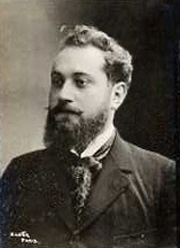Oil painting -> List of Painters -> Albert Guillaume
EARLY DAYS:
Albert Guillaume was a French painter and illustrator who was born in Paris on November 12, 1873. He was the son of a cabinet maker, and he studied at the École des Beaux-Arts in Paris. He initially studied painting, but later changed to the study of decorative arts and illustration.
Guillaume began his career as an illustrator in 1892, working for various magazines and newspapers. He was most notably the illustrator for the satirical magazine Le Rire, where he created hundreds of caricatures of prominent people. His drawings were noted for their sharp wit and social commentary.
In 1895, Guillaume began to experiment with his painting, and by 1897 he had his first solo exhibition at the Salon des Indépendants. His work was generally well-received and he was given awards for his paintings at the Salon for several years. He was associated with several avant-garde artistic movements, such as Symbolism and Fauvism.
Guillaume painted a variety of subjects, including landscapes, portraits, and still lifes. He was known for his bright and vibrant use of color, which was often inspired by his travels to various countries. He was particularly inspired by the art of Japan and the Middle East, and often incorporated elements of these cultures into his works.
In addition to painting, Guillaume continued to illustrate throughout his career. He illustrated several books, including works by Marcel Proust and Emile Zola. He also illustrated several posters and advertisements, many of which featured his signature wit and social commentary.
In 1914, Guillaume was drafted into the French army, and he served during World War I. After the war, he returned to creating art, but his style had changed to a more somber, realistic approach. He continued to paint and illustrate until his death in 1942.
Throughout his career, Guillaume was highly respected as both a painter and illustrator. His work was often described as witty and humorous, but also deeply moving. He was a master at capturing emotion and atmosphere in his works, and was considered one of the most important French painters of the early 20th century. His works remain highly sought after and can be found in museums and private collections around the world.

Personal Details:
CAREER:
Guillaume quickly established himself as a popular figure in the city's art circles, and was known for his distinct style which blended traditional painting techniques with a modern eye for detail. His early works often featured Parisian street scenes, capturing the hustle and bustle of city life with an accuracy not seen in other works of the period.
As Guillaume's career progressed, he began to explore new styles of painting, often experimenting with brighter colors and a more impressionistic approach. His works began to feature more abstract elements, and he increasingly used the cityscape as a backdrop for his art. He was also one of the first painters to depict the modern city as a whole, instead of focusing on individual buildings or streets.
In the years leading up to World War I, Guillaume's career began to gain more recognition. He exhibited at several of the major art galleries in Paris, and was even invited to participate in the famous Salon des Independants exhibition in 1907. His works were also featured in several major publications, including La Revue Blanche and L'Illustration.
In the 1920s and 1930s, Guillaume's career continued to develop, with his works becoming increasingly popular. He began to experiment with more abstract elements, and his paintings often featured bright colors and a fluid, almost dreamlike quality. He also began to focus on the human figure, creating works that captured the emotion and humanity of everyday life.
Guillaume's career came to an end in 1940, when he died at the age of 67. However, his legacy lives on in the works he left behind. To this day, his paintings remain some of the most iconic images of Parisian life, and his influence can be seen in many modern works of art.







